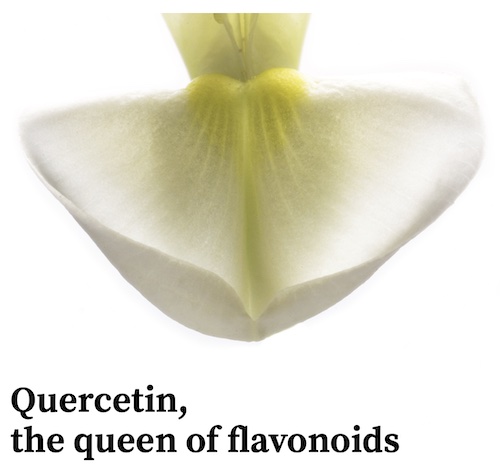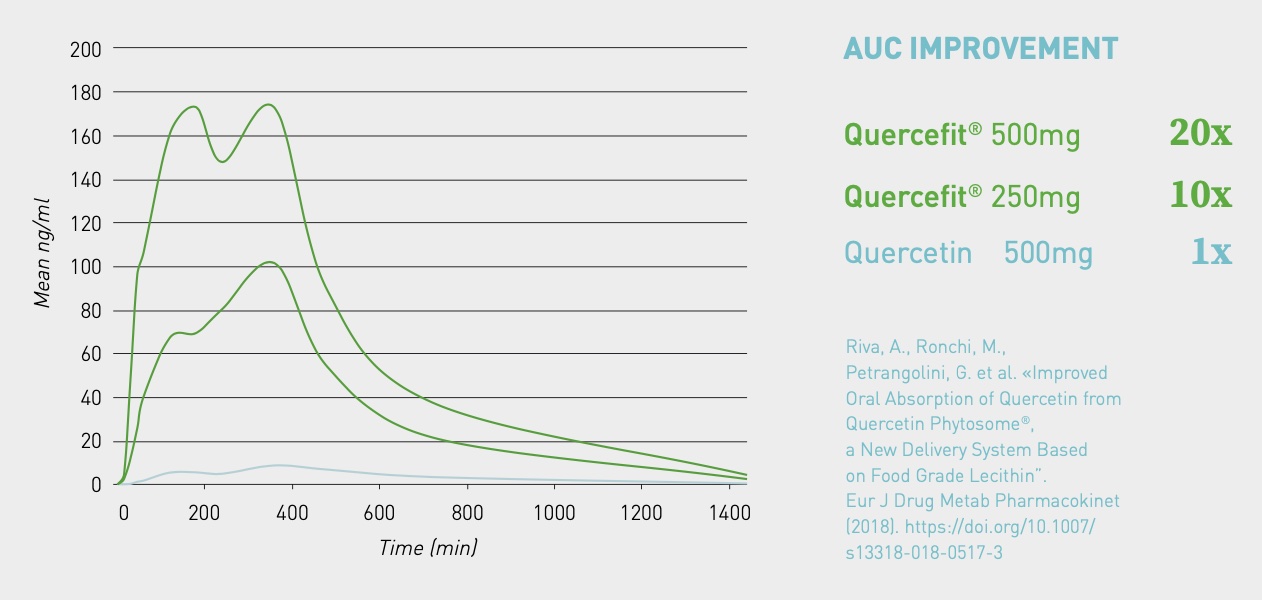17 Best Quercetin Supplements

- 250 mg Quercefit® Phytosome per capsule
- Without additives that hinder absorption or cause allergies

- Formula for the immune system
- Contains 250 mg quercetin per capsule

- 250 mg Quercefit® Phytosome per capsule
- Quercetin extract from honey tree

- Formula for the immune system
- Contains a mix of vitamins, herbs and plant extracts

- Contains 250 mg quercetin and lecithin per capsule
- Quercetin extract from honey tree

- Formula for more energy
- Contains nicotinamide, riboside (200 mg per capsule), quercetin, trans-resveratrol and betaine

- Contains 28 powerhouse ingredients
- Combination of greens, mushrooms, adaptogens and antioxidants

- Contains 250 mg quercetin and 100 mg bromelain per capsule
- In easily absorbable phytosome form

- Contains 500 mg of quercetin per capsule
- Vegetarian capsules

- Contains 500 mg of quercetin per capsule
- Suitable for vegetarians and vegans

- Contains 250 mg quercetin per capsule
- All natural extract

- Contains 250 mg liposomal quercetin per capsule
- Better absorbable due to liposome uptake system

- Formula for more energy
- Contains nicotinamide, riboside (300 mg per capsule), quercetin, trans-resveratrol and fisetin

- Contains 1000 mg of vitamin C per tablet
- Contains 15 mg bio-quercetin phytosome per tablet

- Formula for the immune system
- Contains quercetin, vitamins A, C, D and K, selenium and zinc

- Contains 312 mg of bio-fitesin and 275 mg theaflavins per 3 capsules (weekly dose)
- Supplemented with quercetin en apigenin

- 250 mg Quercefit® Phytosome per capsule
- Supplemented with vitamin C and zinc
Buy Quercetin (TIP: Quercetin Phytosome®)

If you buy your quercetin at Kruidvat, Holland and Barrett (De Tuinen), Etos or anywhere else, even if you buy it from us: read the label carefully to make sure it contains natural quercetin extract.
Or even much better: Quercefit Phytosome®. Because Quercefit is not only a 100% natural quercetin extract, but here the quercetin is coupled with phosphatidylcholine (lecithin) which allows for 20 times better absorption in the intestines.
What is Quercetin?
Quercetin (quercetin in English) belongs to the flavonols. And flavonols, in turn, belong to the (bio)flavonoids. Flavonoids are a group of substances found in many plants.
Flavonoids have many different colors and provide the red, yellow and blue colors of flowers (which serves the purpose of attracting insects). Quercetin is yellow.
Food: What food contains Quercetin?
Quercetin in food is found in vegetables, berries, fruits, herbs, nuts, seeds, cocoa, wine and tea, among others. Flavonoids tend to have a distinctive bitter taste.
In highly processed fruits and vegetables, the amount of quercetin and other flavonoids is greatly reduced and the bitter taste is often largely absent. Admittedly, "eating that tastes better," but the specificity (of chicory, for example) disappears, as do the health-promoting effects.
Preservation of food under inferior conditions, peeling of fruit and heating during preparation cause the amount of quercetin to decrease significantly.
Quercetin in food (average per 100 grams):

- Cappers (235 mg)
- Carob fiber (60 mg)
- Dill (55 mg)
- Coriander (53 mg)
- Red onion (32 mg)
- Radicchio (32 mg)
- Watercress (30 mg)
- Buckwheat (23 mg)
- Kale (23 mg)
- Appples (19 mg)
- Cranberries (15 mg)
- Black plums (12 mg)
- Sweet potato (10 mg)
(Source: www.ahealthylife.nl)
Quercetin 500 mg, 1000 mg?
There are products on the market with 500 mg and 1000 mg of quercetin per capsule. We also have products with 500 mg of quercetin in our range. However, these dosages do not contain the quercetin in easily absorbable phytosome form. Quercetin in phytosome form usually contains 250 mg quercetin per capsule and is highly absorbable. So you are better off using a supplement containing quercetin in phytosome form.
How does Quercetin work?

Quercetin is a flavonol, a bioflavonoid found in plants for protection against attack by external influences: in plants, they play an important role in metabolism and as protection against stressors such as heat, radiation, oxidation, insects and microorganisms.
When to take quercetin? Quercetin is best taken with or just after meals.
Quercetin experiences
Experiences with quercetin are obviously positive. It is not called the "Queen of flavonoids" for nothing. Much scientific research is being done on the effects of quercetin and taxifolin (dihydroquercetin).
Taxifolin is closely related to quercetin. And although taxifolin was previously thought to be even more effective than "normal" quercetin, new studies show that quercetin is still a stronger antioxidant than taxifolin.
Use less for more

But if you want to take full advantage of quercetin, use only Quercefit®, the patented Phytosome ingredient from Italian company Indena.
500 mg of Quercefit® contains about 200 mg of pure quercetin. However, because of the 20 x better absorption thanks to Phytosome technology, as much quercetin is absorbed from the intestines into the blood as with four large quercetin 1000 mg tablets.
Also, Quercefit® contains about 200 mg of pure quercetin.
In addition, with Quercefit® it is possible to trace where the raw materials come from and not with standard quercetin 1000 mg supplements. In other words, guaranteed purity.
Quercetin Phytosome®
Quercetin from food is often lost through storage and processing such as cooking, cutting and peeling. Moreover, flavonoids are generally poorly absorbed by the intestines because of their poor solubility and tendency to clump together. Quercetin bound to lipids, however, is well absorbed.
So there is phytosomal and liposomal quercetin. In liposomal quercetin, the quercetin is encapsulated in fat globules (called phospholipids) that carry the quercetin through the intestinal wall. Quercetin phytosome (or phytosome) involves a homogeneous mixture of the active ingredient and phospholipids, rather than encapsulation. The quercetin particles adhere to the phospholipids and thus pass through the intestinal wall.

Phytosomal quercetin is therefore absorbed up to 20x better than regular quercetin extract. Moreover, it requires fewer phospholipids than liposomal preparation.
Quercetin side effects
Quercetin supplements have been used for decades. It is a very safe supplement. No side effects have been reported, with the exception of a few who react sensitively because of an allergy and get a headache or mild stomach upset.
Quercetin with Zinc
Quercetin can be used well in combination with other supplements such as zinc. Zinc is an essential mineral for the entire body and protects cells from oxidative stress and has a supportive effect on the immune system.
People who buy Quercetin also view:
Written by: Sofie Graas and Marcella van der Wel
Reviewed and edited by: Wouter Olthof
Updated: November 29, 2022
